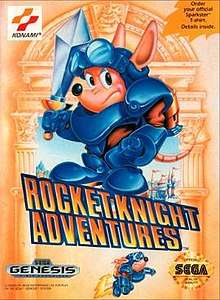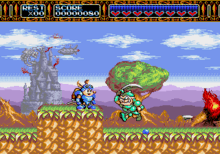Rocket Knight Adventures
Rocket Knight Adventures (ロケットナイトアドベンチャーズ, Roketto Naito Adobenchāzu) is a 1993 side-scrolling platformer video game developed and published by Konami for the Sega Genesis. The game was released in North America on August 5, 1993, in Japan on August 6, 1993, and in Europe in 1993. Rocket Knight Adventures was designed by Nobuya Nakazato, designer of several titles in the Contra series such as The Alien Wars, Hard Corps and Shattered Soldier. Its protagonist is Sparkster, an opossum knight who fights an army of robots and pigs, many of whom are piloting various mechanical vehicles. Sparkster is armed with a sword that can project energy over a short distance and a rocket pack that allows him to fly.
| Rocket Knight Adventures | |
|---|---|
 North American Genesis box art | |
| Developer(s) | Konami |
| Publisher(s) | Konami |
| Director(s) | Nobuya Nakazato |
| Producer(s) | Tomikazu Kirita |
| Designer(s) | Nobuya Nakazato Shiori Satoh |
| Programmer(s) | Kenichiro Horio Koji Komata Kenji Miyaoka |
| Artist(s) | Yasushi Takano |
| Composer(s) | Masanori Oouchi Aki Hata Michiru Yamane Masanori Adachi Hiroshi Kobayashi Akira Yamaoka |
| Platform(s) | Sega Genesis |
| Release | |
| Genre(s) | Platformer, scrolling shooter |
| Mode(s) | Single-player |
Gameplay

Gameplay is often a side scrolling platform, with linear runs through levels. The player is able to jump, attack with Sparkster's sword, either directly or by "shooting" energy forward when swung, or charge up their rocket pack and go flying in one of the 8 standard directions, depending of the direction the player presses (if no direction is pressed, Sparkster performs a stationary spinning attack).
Levels are occasionally switched up with alternate styles of gameplay. Some levels are horizontal scrolling shooters (akin to Gradius, often with in-level references to that game), while one level has the player controlling a large machine to duel with Axel Gear.
The difficulty levels in the game are differently presented in each regional version of the game. Both the Japanese and European versions have two difficulty levels accessible normally via the options menu, while in the American version four are enabled by default.
Plot
The first King El Zebulos repelled some invaders in a powerful ship called the Pig Star and was made ruler of the land. Knowing the Pig Star had the power to destroy entire worlds, El Zebulos had it placed under a magic seal for safekeeping. The "Key to the Seal" would be guarded and passed down by El Zebulos, and his Royal Family. Generations into the future, the kingdom has been subject to attack by neighboring countries which wanted control of The Pig Star. To protect the kingdom of Zebulos, an elite group of warriors known as the Rocket Knights were formed. These Warriors wore armor with Rocket Packs, wielded mystical swords, and harnessed awesome combat skills.
Around this time, an orphan named Sparkster was taken in by Mifune Sanjulo; a friend of the King, and current leader of the Rocket Knights. Sparkster was trained to become a Rocket Knight at an early age. Later on, a corrupt Rocket Knight by the name of Axel Gear fought and wounded Mifune as he tried to steal an ancient book, which contained the secrets of the rocket knights. Sparkster was appointed the new Rocket Knight leader and spent 10 years posing as an outlaw as he searched for Axel Gear, only to return to Zebulos and hear rumors about Axel Gear's return.
By now the Kingdom is under attack by the Devotindos Empire led by Emperor Devligus Devotindos; who is said to have the power of hypnosis. Sparkster finds that Axel Gear has kidnapped Princess Sherry in attempt to blackmail the king into surrendering The "Key to the Seal". However it just so happens that the Princess is the only one who knows of its location. Sparkster rushes through jungles, caves, and even into Devotindos territory to save the princess, until he finally confronts Devilgus himself, who quickly flees after he gets the "Key to the Seal" from the Princess and takes off into space to The Pig Star. The Princess casts a spell on Sparkster to allow him to go after Devilgus and into The Pig Star. Sparkster fights the Emperor himself, only to discover he was a machine all along. Exploring the spaceship shows that Devilgus was not unique as the ship was a factory of Devilgus robots.
After Devilgus' destruction, Sparkster runs into Axel Gear, who tries to jettison Sparkster into space, but gets sucked into space instead. Inside the ship's core, Sparkster discovers that the real Devligus was the Pig Star's core itself, hinting that the Emperor Devilgus was but a robotic proxy sent to Earth to establish an empire to invade Zebulos in an attempt to break free from its confinement. The ship's core attempts to destroy Sparkster. However, its efforts fail as The Pig Star explodes, and it makes a last-ditch effort to kill Sparkster while he is defenseless in an escape pod, eventually burning apart in Elhorn's atmosphere. Sparkster escapes in one piece and reaches the castle with Princess Sherry. Satisfied that the kingdom is safe, Sparkster flies off to continue his duties.
Development
Ports, sequels and spin-offs
A SNES version of Rocket Knight Adventures was planned, but was never released.
Two follow-up titles Sparkster: Rocket Knight Adventures 2 on the Mega Drive, and Sparkster on the SNES were released. Despite both games being produced simultaneously and sharing the same name and box art, they were different games, sharing only their character design and music score, with the Mega Drive release acting as a direct sequel and the SNES game being a spin-off. The two titles are often confused for being the same game due to the "Rocket Knight Adventures 2” subtitle only being employed in Japan.
In October 2009, Konami announced they would release another sequel, titled Rocket Knight (which is the sequel to the Sega Megadrive/Genesis game called Sparkster: Rocket Knight Adventures 2, but not really a remake of the Sega Megadrive/Genesis game called Rocket Knight Adventures), made by the British developer, Climax Group. The game was released on Xbox 360, PlayStation 3 and Steam on May 12, 2010. Nobuya Nakazato was not involved with this title in any way,[1] though Nazakato was credited by the developers in the Special Thanks section of the game credits.
Sparkster has appeared as a playable character in a few recent titles, such as New International Track & Field for Nintendo DS and Krazy Kart Racing for iPhone and iPod Touch. He also has cameos in Ganbare Goemon 2: Kiteretsu Shōgun Magginesu for the SNES, Snatcher for the Mega-CD, Jikkyō Power Pro Wrestling '96: Max Voltage for the SNES, Mitsumete Knight for the PlayStation, They was disguised by Pastel in TwinBee PARADISE in Donburishima for PC, and a figure resembling him also appears in an alternate ending to Contra: Shattered Soldier for the PlayStation 2, and as nonogram pixel on Pixel Puzzle Collection for the iPhone and Android.
A Sparkster comic was written by Nigel Kitching in the UK-made Sonic the Comic. It was based on the Mega Drive/Genesis version of Sparkster. In an interview, Kitching said that Sparkster was the easiest game to adapt into a story, due to being similar to the Sonic the Hedgehog games. He was working on a second Sparkster story, but the plan was dropped when Fleetway were unable to obtain permission from Konami to use the character.
Reception
| Reception | ||||||||||||||||||||||||||
|---|---|---|---|---|---|---|---|---|---|---|---|---|---|---|---|---|---|---|---|---|---|---|---|---|---|---|
| ||||||||||||||||||||||||||
Sparkster stood out in the Animal mascot era, with gamers labeling him a second prodigy for Sega behind Sonic. Rocket Knight Adventures was well received by critics, who praised the music and graphics. HonestGamers gave the game a 9/10. Sega-16 gave it the same mark, saying that "it is not only one of the system’s best titles, it’s one of the greatest platformers ever made."[12]
References
- Ken Horowitz (April 27, 2010). "Preview: Rocket Knight". Sega-16. Retrieved June 13, 2014.
- Computer and Video Games, issue 142, pages 42-44
- Electronic Gaming Monthly, issue 52 (November 1993), page 48
- GamePro, issue 50 (September 1993), pages 28-29
- GamesMaster, issue 9, pages 60-61
- http://www.honestgamers.com/1639/genesis/rocket-knight-adventures/review.html
- Joypad, issue 23, pages 60-62
- http://segaretro.org/index.php?title=File:MeanMachinesSega11UK.pdf&page=82
- Mega Action, issue 4, pages 10-11
- MegaTech, issue 20, pages 44-47
- Player One, issue 34, pages 92-95
- Ken Horowitz (June 24, 2004). "Rocket Knight Adventures". Sega-16. Retrieved June 13, 2014.